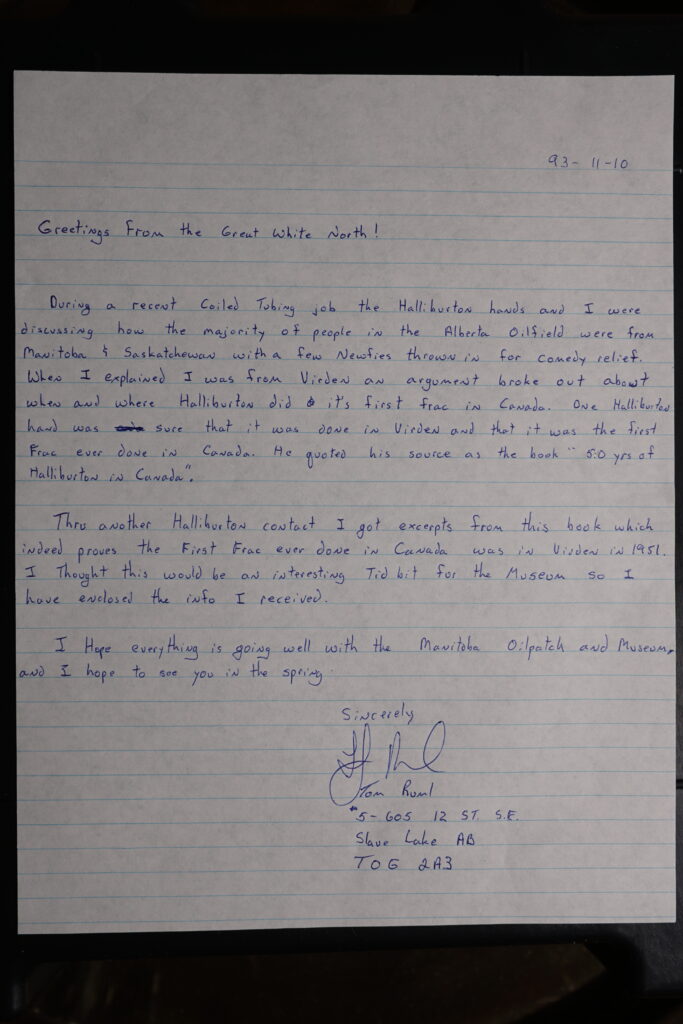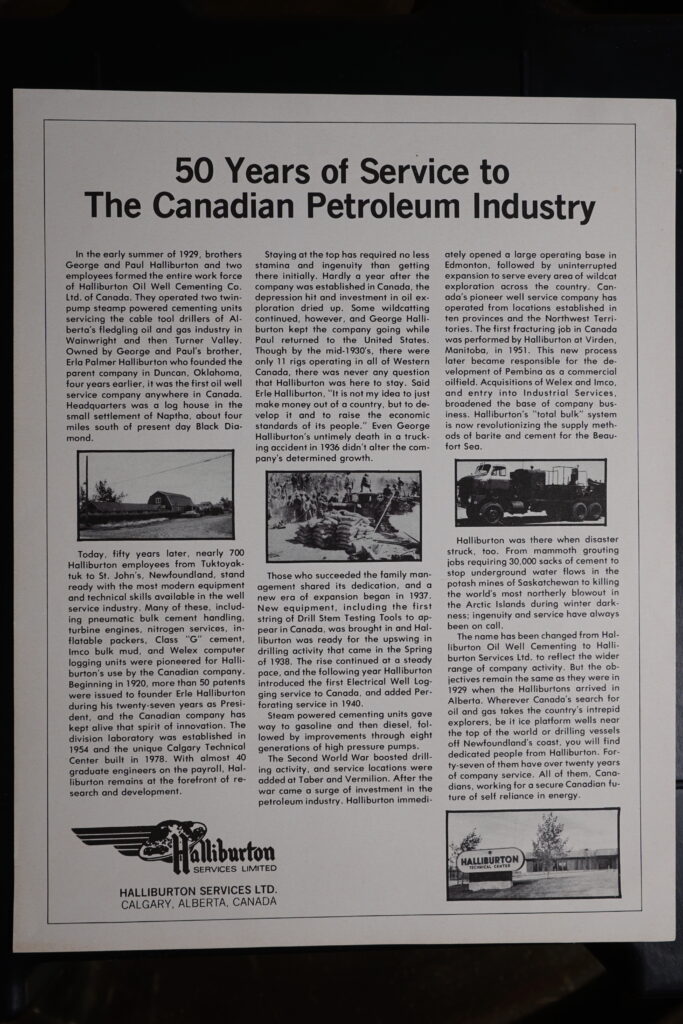Contact
PO Box 2397
Virden Manitoba
R0M 2C0
ManitobaOilMuseum@gmail.com
Halliburton Story
In 1993, the MOMIC received this letter from a member regarding Manitoba as the site of
the first fracking operation by Halliburton, an oil and gas technology and service company. The
following is the hand-written letter from Tom Ruml, as well as an enclosed pamphlet from
Halliburton Services Ltd. This pamphlet explains the history of the Halliburton company, as well
as evidence that Virden, Manitoba was the site of the first “frack” in Canada.
The Letter

Greetings From the Great White North!
During a recent coiled Tubing job the Halliburton hands and I were discussing how the majority of people in the Alberta Oilfield were from Manitoba & Saskatchewan with a few newfies thrown in for comedy relief. When I explained I was from Virden an argument broke out about when and where Halliburton did its it's first frac in Canada. One Halliburton hand was sure that it was done in Virden and that it was the first frac ever done in Canada. He quoted his source as the book "50 yrs of Halliburton in Canada".
Thru another Halliburton contact I got excerpts from this book which indeed proves the First Frac ever done in Canada was in Virden in 1951. I thought this would be an interesting tid bit for the museum so I have enclosed the info I received.
I hope everything is going well with the Manitoba Oilpatch and Museum, and I hope to see you in the spring.
Sincerely,
Tom Ruml
50 Years of Service to The Canadian Petroleum Industry

In the early summer of 1929, brothers George and Paul Halliburton and two employees formed the entire work force of Halliburton Oil Well Cementing Co. Ltd. of Canada. They operated two twin-pump steam powered cementing units servicing the cable tool drillers of Alberta's fledgling oil and gas industry in Wainwright and then Turner Valley. Owned by George and Paul's brother, Erla Palmer Halliburton who founded the parent company in Duncan, Oklahoma, four years earlier, it was the first oil well service company anywhere in Canada. Headquarters was a log house in the small settlement of Naptha, about four miles south of present day Black Diamond.
Today, fifty years later, nearly 700 Halliburton employees from Tuktoyaktuk to St John's, Newfoundland, stand ready with the most modern equipment and technical skills available in the well service industry. Many of these, including pneumatic bulk cement handling, turbine engines, nitrogen services, inflatable packers. Class "G" cement, Imco bulk mud, and Welex computer logging units were pioneered for Halliburton's use by the Canadian company. Beginning in 1920, more than 50 patents were issued to founder Erle Halliburton during his twenty-seven years as President, and the Canadian company has kept alive that spirit of innovation. The division laboratory was established in 1954 and the unique Calgary Technical Center built in 1978. With almost 40 graduate engineers on the payroll, Halliburton remains at the forefront of research and development.
Staying at the top has required no less stamina and ingenuity than getting there initially. Hardly a year after the company was established in Canada, the depression hit and investment in oil exploration dried up. Some wildcatting continued, however, and George Halliburton kept the company going while Paul returned to the United States. Though by the mid-1930's, there were only 11 rigs operating in all of Western Canada, there was never any question that Halliburton was here to stay. Said Erle Halliburton, "It is not my idea to just make money out of a country, but to develop it and to raise the economic standards of its people." Even George Halliburton's untimely death in a trucking accident in 1936 didn't alter the company's determined growth.
Those who succeeded the family management shared its dedication, and a new era of expansion began in 1937. New equipment, including the first string of Drill Stem Testing Tools to appear in Canada, was brought in and Halliburton was ready for the upswing in drilling activity that came in the Spring of 1938. The rise continued at a steady pace, and the following year Halliburton introduced the first Electrical Well Logging service to Canada, and added Perforating service in 1940.
Steam powered cementing units gave way to gasoline and then diesel, followed by improvements through eight generations of high pressure pumps.
The Second World War boosted drilling activity, and service locations were added at Taber and Vermilion. After the war came a surge of investment in the petroleum industry. Halliburton immediately opened a large operating base in Edmonton, followed by uninterrupted expansion to serve every area of wildcat exploration across the country. Canada's pioneer well service company has operated from locations established in ten provinces and the Northwest Territories. The first fracturing job in Canada was performed by Halliburton at Virden, Manitoba, in 1951. This new process later became responsible for the development of Pembina as a commercial oilfield. Acquisitions of Welex and Imco, and entry into Industrial Services, broadened the base of company business. Halliburton's "total bulk" system is now revolutionizing the supply methods of barite and cement for the Beaufort Sea.
Halliburton was there when disaster struck, too. From mammoth grouting jobs requiring 30,000 sacks of cement to stop underground water flows in the potash mines of Saskatchewan to killing the world's most northerly blowout in the Arctic Islands during winter darkness; ingenuity and service have always been on call.
The name has been changed from Halliburton Oil Well Cementing to Halliburton Services Ltd. to reflect the wider range of company activity. But the objectives remain the same as they were in 1929 when the Halliburtons arrived in Alberta. Wherever Canada's search for oil and gas takes the country's intrepid explorers, be it ice platform wells near the top of the world or drilling vessels off Newfoundland's coast, you will find dedicated people from Halliburton. Forty-seven of them have over twenty years of company service. All of them, Canadians, working for a secure Canadian future of self reliance in energy.